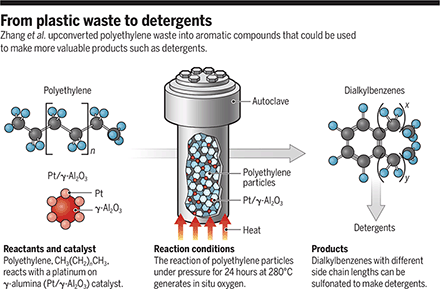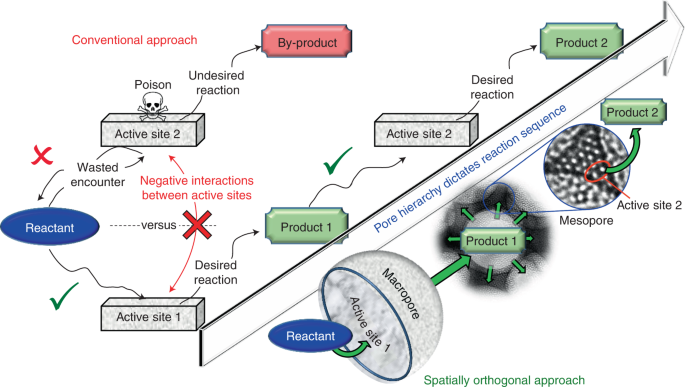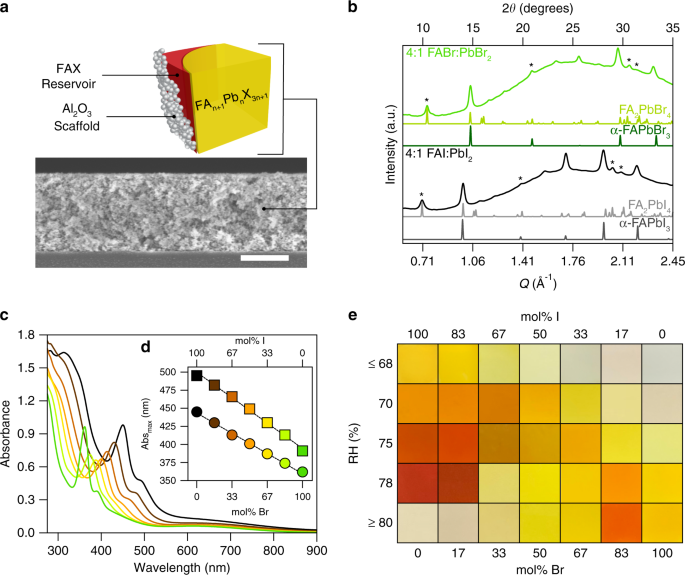2020/10/22 アメリカ合衆国・カリフォルニア大学サンタバーバラ校(UCSB)

・ UCSB、イリノイ大学アーバナ・シャンペーン校およびコーネル大学が、比較的低温度でのワンポット・タンデム触媒法による、ポリエチレンをアルキル芳香族分子に直接アップサイクルする技術を開発。
・ 世界市場価値が年間約 2 千億ドルのポリエチレンは、プラスチック全製品の約 1/3 で使用されている。プラスチックはリサイクルするよりも製造と廃棄処理が安価で容易であるが、エネルギーを大量に消費することなくポリマーを高価値の分子に直接転換できれば、廃プラのリサイクルは環境保全の利点を備えた魅力的で実用的な対処方法となる。
・ 腐食性の化学薬品を貯蔵するプラスチックボトル等のように、プラスチックはその化学的な不活性により通常では環境中の他の成分には反応しない。自然な分解には長い時間がかかり、人工的な分解に大量のエネルギーを要するのはこの不活性のため。
・ 今回開発した白金とアルミナ(Pt/Al2O3)の触媒によるタンデム反応技術では、複数の変換を回避してプロセス数を低減し、溶媒や水素の追加も不要。約 300℃の比較的マイルドな反応条件下で、強力な炭素-炭素結合を切断してポリマー分子の「骨格」を再配置し、ペンキや潤滑油、洗剤等の様々な工業・消費者製品に使用できるアルキル芳香族分子を形成する。
・ 従来のポリオレフィン鎖の分解からガス、液体とコークスの混合製品への再構築には 500~1000℃の高温を必要とする。また、小さな炭化水素による芳香族分子の形成は困難だが、新技術ではポリオレフィンからの芳香族形成時に副生物として形成される水素がポリマー鎖を切断する。
・ 同技術の最大の効果を見極めるためにさらに研究を進める必要があるが、廃プラの環境蓄積を緩和しながらその価値を回収し、プラスチックを作る石油への依存度の低減を助ける一つの対策と考える。
URL: https://www.news.ucsb.edu/2020/020072/closing-plastic-loop6
<NEDO海外技術情報より>
(関連情報)
Science 掲載論文(アブストラクトのみ:全文は有料
Polyethylene upcycling to long-chain alkylaromatics by tandem hydrogenolysis/aromatization
URL: https://science.sciencemag.org/content/370/6515/437
(関連情報)
Science 掲載論文(アブストラクトのみ:全文は有料
Creating value from plastic waste
URL: https://science.sciencemag.org/content/370/6515/400
Abstract
Plastic waste presents a number of environmental problems (1–3). Although only a small fraction of it enters rivers, lakes, and oceans, it can be transformed there into micro- and nanoplastics that are harmful to aquatic organisms. When plastic waste is buried in landfills or incinerated, it generates heat and carbon dioxide. However, plastic waste also offers great opportunities if its economic value can be increased substantially through upcycling processes that convert it into more valuable chemical products. On page 437 of this issue, Zhang et al. (4) report on an upcycling process that converts polyethylene (often used for packaging and grocery bags) into long-chain alkylaromatics that can be sulfonated to make biodegradable surfactants. This process operates at a moderate reaction temperature, does not need any solvent or added hydrogen, and produces only a small amount of light-gas by-products such as methane.



